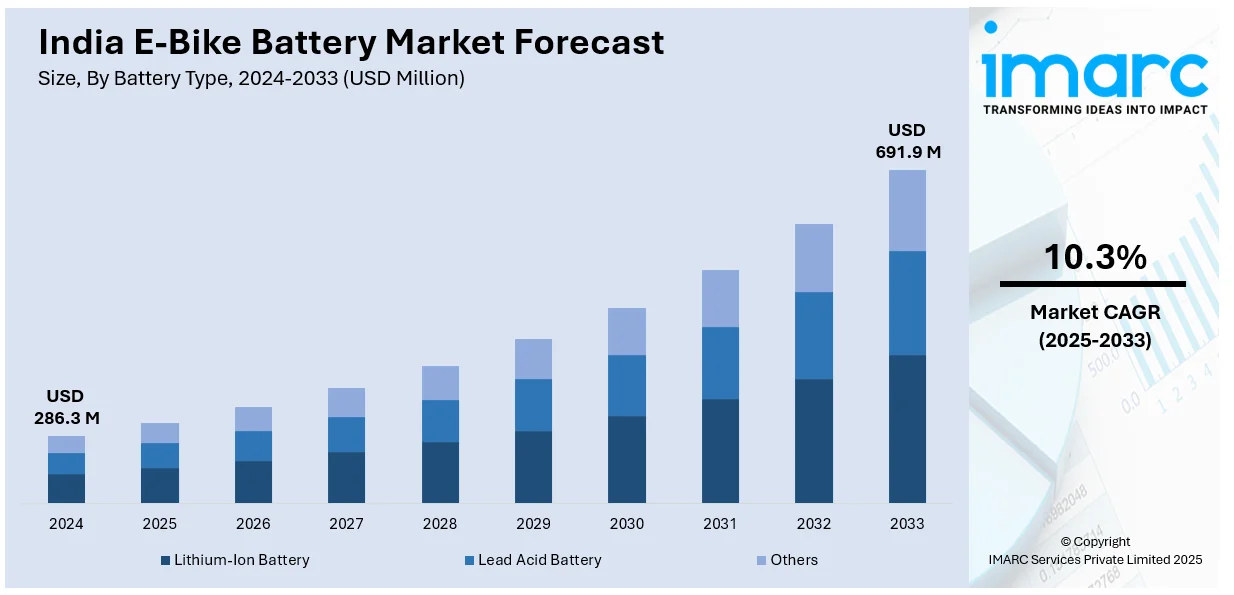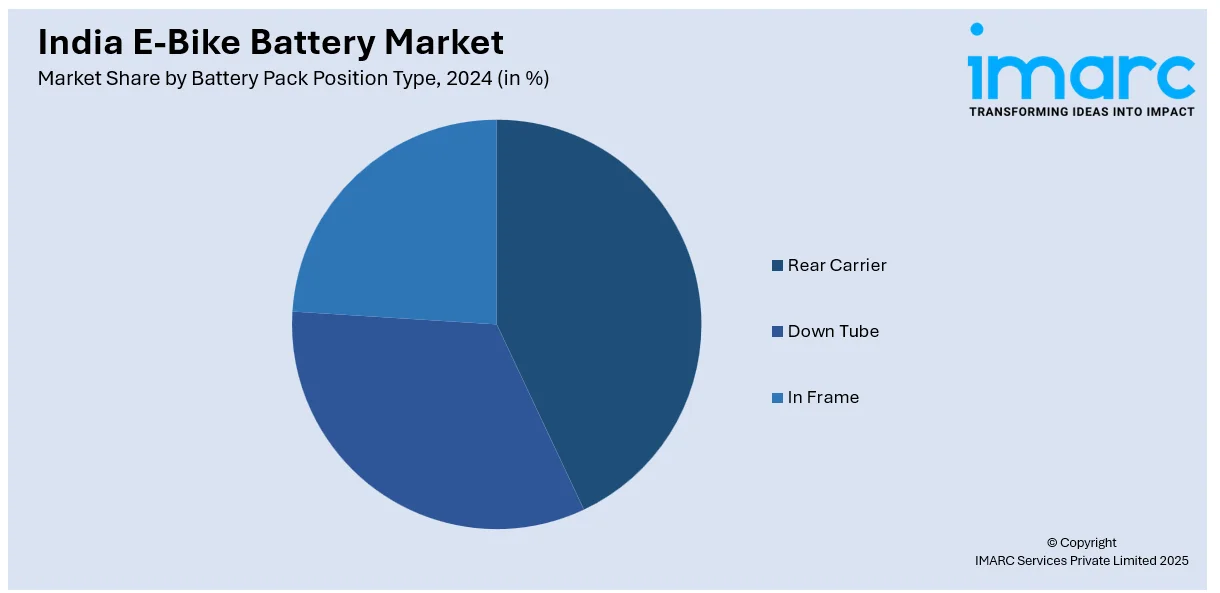
India E-Bike Battery Market Size, Share, Trends and Forecast by Battery Type, Battery Pack Position Type, and Region, 2025-2033
India E-Bike Battery Market Overview:
The India E-bike battery market size reached USD 286.3 Million in 2024. Looking forward, IMARC Group expects the market to reach USD 691.9 Million by 2033, exhibiting a growth rate (CAGR) of 10.3% during 2025-2033. The market is driven by government incentives under the FAME-II scheme, advancements in battery-swapping infrastructure, rising investments in indigenous battery production, increasing fuel prices pushing EV adoption, and growing consumer demand for sustainable mobility solutions, all contributing to the expansion of the electric two-wheeler ecosystem across the country.
|
Report Attribute
|
Key Statistics
|
|---|---|
|
Base Year
|
2024
|
|
Forecast Years
|
2025-2033
|
|
Historical Years
|
2019-2024
|
| Market Size in 2024 | USD 286.3 Million |
| Market Forecast in 2033 | USD 691.9 Million |
| Market Growth Rate 2025-2033 | 10.3% |
India E-Bike Battery Market Trends:
Government Policies and Incentives
India government has put forward a range of policies and schemes to encourage electric mobility, affecting the E-bike battery sector directly. The key program is the Faster Adoption and Manufacturing of (Hybrid &) Electric Vehicles (FAME) initiative. FAME came into existence in 2015 and seeks to spur the drive toward electric as well as hybrid vehicles. The second phase, FAME-II, began in April 2019 with a budgetary outlay of INR 10,000 crore until March 2024. This phase focused on incentives for electric two-wheelers, three-wheelers, and buses, where a large part goes to two-wheelers, a segment that includes E-bikes. To support indigenous battery production, the government cleared a Production Linked Incentive (PLI) scheme in May 2021 for ACC manufacturing. This effort will cut down the cost of batteries, eventually decreasing e-bike prices and making them more affordable. Furthermore, the Goods and Services Tax (GST) for electric vehicles has been brought down from 12% to 5%, and on chargers/charging stations from 18% to 5%, encouraging consumers as well as manufacturers additionally. All these policies have reaped tangible benefits. Up until July 2022, India had reported more than 1.3 million electric vehicles, with a good majority being two-wheelers. This rise in the adoption of electric two-wheelers has led to a direct rise in the demand for e-bike batteries, driving the market growth.

To get more information on this market, Request Sample
Environmental Concerns and Sustainability
Environmental factors are playing a major role in shaping consumer attitudes toward electric mobility in India. The transport sector is one of the largest contributors to air pollution, causing negative health impacts. To counter this, India has embraced policies that encourage electric vehicles (EVs) and power sector decarbonization. Studies have shown that environmental concern is a significant predictor of EV adoption intention among Indian consumers. One study that incorporated environmental concern into the Theory of Planned Behavior established that growing environmental awareness has a positive effect on the intention to buy EVs. The government's dedication to environmental sustainability is also reflected in its goal to attain a minimum of 30% electric vehicle adoption by 2023, joining the world effort of eliminating carbon emissions. This goal highlights the focus on lessening vehicular emissions, hence enhancing air quality. The overall impact of these environmental issues and measures has been a significant rise in EV uptake. Around 329,190 electric vehicles were sold in India in 2021, a 168% rise compared to 2020 sales. This growth also encompasses a considerable number of electric two-wheelers, which are directly escalating the demand for E-bike batteries.
India E-Bike Battery Market Segmentation:
IMARC Group provides an analysis of the key trends in each segment of the market, along with forecasts at the region/country level for 2025-2033. Our report has categorized the market based on battery type and battery pack position type.
Battery Type Insights:
- Lithium-Ion Battery
- Lead Acid Battery
- Others
The report has provided a detailed breakup and analysis of the market based on the battery type. This includes lithium-ion battery, lead acid battery, and others.
Battery Pack Position Type Insights:

- Rear Carrier
- Down Tube
- In Frame
A detailed breakup and analysis of the market based on the battery pack position type have also been provided in the report. This includes rear carrier, down tube, and in frame.
Regional Insights:
- North India
- South India
- East India
- West India
The report has also provided a comprehensive analysis of all the major regional markets, which include North India, South India, East India, and West India.
Competitive Landscape:
The market research report has also provided a comprehensive analysis of the competitive landscape. Competitive analysis such as market structure, key player positioning, top winning strategies, competitive dashboard, and company evaluation quadrant has been covered in the report. Also, detailed profiles of all major companies have been provided.
India E-Bike Battery Market News:
- August 2024: Sun Mobility collaborated with Odysse Electric to offer battery-swapping technologies for the Vader SM E-bike, improving convenience and accessibility. This reduces charging time and range anxiety, stimulating more consumers to take up E-bikes. Consequently, the demand for E-bike batteries surges, generating market growth.
- June 2024: Ola Electric's innovation of solid-state battery technology changed India's E-bike battery landscape by providing improved energy density and safety aspects. This new development created lighter and more efficient batteries, which in turn led to a rise in the range and durability of electric bicycles, thereby propelling the India E-bike battery market.
India E-Bike Battery Market Report Coverage:
| Report Features | Details |
|---|---|
| Base Year of the Analysis | 2024 |
| Historical Period | 2019-2024 |
| Forecast Period | 2025-2033 |
| Units | Million USD |
| Scope of the Report | Exploration of Historical Trends and Market Outlook, Industry Catalysts and Challenges, Segment-Wise Historical and Future Market Assessment:
|
| Battery Types Covered | Lithium-ion Battery, Lead Acid Battery, Others |
| Battery Pack Position Types Covered | Rear Carrier, Down Tube, In Frame |
| Regions Covered | North India, South India, East India, West India |
| Customization Scope | 10% Free Customization |
| Post-Sale Analyst Support | 10-12 Weeks |
| Delivery Format | PDF and Excel through Email (We can also provide the editable version of the report in PPT/Word format on special request) |
Key Benefits for Stakeholders:
- IMARC’s industry report offers a comprehensive quantitative analysis of various market segments, historical and current market trends, market forecasts, and dynamics of the India E-bike battery market from 2019-2033.
- The research report provides the latest information on the market drivers, challenges, and opportunities in the India E-bike battery market.
- Porter's five forces analysis assist stakeholders in assessing the impact of new entrants, competitive rivalry, supplier power, buyer power, and the threat of substitution. It helps stakeholders to analyze the level of competition within the India E-bike battery industry and its attractiveness.
- Competitive landscape allows stakeholders to understand their competitive environment and provides an insight into the current positions of key players in the market.
Key Questions Answered in This Report
The India E-bike battery market size reached USD 286.3 Million in 2024.
The India E-bike battery market is projected to reach USD 691.9 Million by 2033, growing at a CAGR of 10.3% during 2025-2033.
Growth is fueled by rising demand for sustainable urban mobility, government incentives for electric vehicles, advancements in battery technology, and increasing consumer preference for eco-friendly and cost-effective transport options.
Need more help?
- Speak to our experienced analysts for insights on the current market scenarios.
- Include additional segments and countries to customize the report as per your requirement.
- Gain an unparalleled competitive advantage in your domain by understanding how to utilize the report and positively impacting your operations and revenue.
- For further assistance, please connect with our analysts.
 Request Customization
Request Customization
 Speak to an Analyst
Speak to an Analyst
 Request Brochure
Request Brochure
 Inquire Before Buying
Inquire Before Buying




.webp)




.webp)












